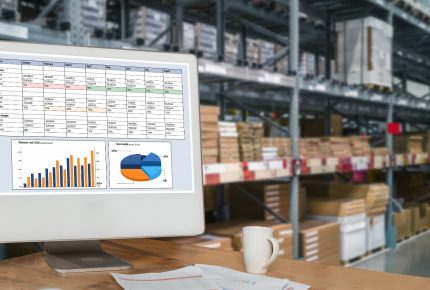The Role of Automation in Inventory Auditing and Cycle Counts

Automation in inventory auditing plays a crucial role in modern inventory management systems by streamlining cycle counts, making them faster and more accurate. Instead of halting all operations to physically count items, automated systems enable businesses to inspect small portions regularly without disruption. This approach reduces human errors, improves accuracy, and helps maintain accurate inventory data continuously.
Robots and automated tools equipped with barcode scanners can navigate warehouses, scan items, and update inventory records in real time. This not only saves time but also lowers the chance of mistakes, making the inventory management process more reliable. Such technology helps companies prevent costly issues like overstocking or slow-moving items.
By bringing automation into cycle counting, businesses can improve efficiency, maintain better control, and enhance customer satisfaction. This section explains the main technologies behind automation, how it improves auditing, and how it differs from manual counting.
The Role of Automation in Inventory Auditing and Cycle Counts
Understanding Automation in Inventory Auditing
Automation in inventory auditing uses advanced tools to track inventory more accurately and quickly. It changes how audits are done by introducing new technologies and improving the process. This section explains the main technologies behind automation, the ways it improves auditing, and how it differs from manual methods.
Key Technologies Used in Automation
Automation relies on several key technologies to improve inventory audits. Barcodes, RFID tags, and smart devices help track items and reduce manual data entry errors. These tools allow real-time updates of inventory data.
Robotic Process Automation (RPA) handles repetitive tasks like data entry and report generation, speeding up audits. Sensors and smart devices connected via the Internet of Things (IoT) give continuous monitoring of stock levels without human input.
Some systems use drones or cameras for visual counts in large warehouses. These technologies combine with AI to detect discrepancies and forecast stock needs more precisely than traditional methods. By leveraging automation in inventory auditing, companies gain a more consistent and trustworthy picture of their stock.
Process Improvements Enabled by Automation
Automation reduces the time-consuming nature of traditional audits. Instead of stopping operations for stock counts, businesses use automation in inventory auditing to perform smaller, continuous counts that keep records current.
Data accuracy improves because automated systems lessen human errors like miscounts or misreporting. Audit trails also become easier to maintain, tracking every change and movement with logs for better accountability.
Automation also reduces overstocking and stockouts by quickly flagging irregularities. Financial departments benefit from faster reconciliation of inventory data with financial records, improving budgeting and planning.
Differences Between Manual and Automated Auditing
Manual auditing depends heavily on people physically counting items, which takes more time and can lead to mistakes. It requires stopping part or all of warehouse operations, causing delays and costs.
Automated auditing uses technology to collect and analyze data faster and more precisely. It can perform counts while operations continue, avoiding disruptions. This method provides better traceability through detailed records and logs.
While manual audits depend heavily on human labor and judgment, automated systems offer consistency and repeatability. However, automated audits still need some human supervision for interpretation and exception handling.
Benefits of Automated Cycle Counts
Automated cycle counts improve key inventory functions by reducing errors, saving time and money, and giving up-to-date stock information. These improvements help businesses make smarter decisions and avoid costly issues like stock shortages or excess.
Increased Accuracy and Reliability
Automation in inventory auditing uses sensors and barcode scanners to count inventory, cutting down human mistakes like miscounts or misplaced items. Robots and software track inventory in real time, ensuring records match actual stock.
This precise tracking reduces inventory shrinkage caused by theft, damage, or errors. It also helps identify discrepancies quickly, so problems can be fixed early. Automated systems keep data consistent, improving trust in stock reports.
Because machines count regularly and more often, businesses get a clearer, continuous picture of their inventory. This ongoing accuracy supports better purchasing and sales planning.
Time and Cost Efficiency
Automated cycle counts save time by eliminating manual counting steps. Robots and scanning devices perform counts faster than people and can work without stopping operations.
With automation, labor costs drop since fewer staff are needed for physical audits. This reduces overtime and minimizes disruptions during busy periods.
Automation also speeds up inventory updates, freeing employees to focus on other tasks. Businesses can schedule cycle counts anytime, avoiding slowdowns during peak hours.
Reducing errors lowers costs further by preventing overstocking or stockouts, which can tie up cash or lose sales. Automation makes inventory control more efficient overall.
Enhanced Real-Time Inventory Visibility
Automated systems provide immediate updates to inventory records as counts happen. This live data helps managers know exactly what stock is on hand without waiting for physical audits.
Real-time visibility reduces guesswork in ordering, shipping, and fulfillment. It supports faster responses to demand changes or supply issues.
By integrating with warehouse management software, automated counts improve tracking across different locations. Managers can monitor stock levels remotely and make informed decisions quickly.
Better visibility also helps spot trends like slow-moving products or unexpected shortages. This insight can guide smarter inventory policies and reduce waste.
Challenges and Best Practices for Implementation
Automation in inventory auditing and cycle counts requires careful planning and attention to specific risks. Common obstacles include technological barriers and workforce adaptation. Best practices focus on clear goal setting, staff training, and selecting the right tools. Data security and compliance also demand strict controls to protect sensitive inventory information.
Common Obstacles in Adopting Automation
One major challenge is the upfront cost of automation technology, which can be high for some companies. Integrating new systems with existing software often causes compatibility issues. Staff resistance is another hurdle, as employees may fear job loss or struggle with new tools.
Technical glitches and data inaccuracies can arise if systems are not properly configured. Additionally, companies may face difficulty scaling automation across multiple locations.
To overcome these obstacles, organizations must assess their current infrastructure and involve staff in the transition early. Clear communication about benefits and expectations helps reduce resistance.
Best Practices for Successful Integration
Successful implementation begins with assessing current pain points to target automation efforts effectively. Companies should set specific, measurable goals focused on improving accuracy and reducing cycle time.
Comprehensive training is essential. All employees involved in inventory processes need hands-on experience with new tools. Regular audits should continue, even after automation, to confirm system reliability.
Choosing technology that fits the company’s size and inventory complexity improves adoption. Combining automated tracking methods, like RFID or IoT sensors, with AI analytics leads to better inventory visibility.
Ongoing monitoring and updates ensure the system adapts to changing business needs and reduces errors.
Ensuring Data Security and Compliance
Automation systems handle sensitive data, including stock levels and transaction histories. Protecting this information requires strong security measures such as encryption, access controls, and regular security audits.
Compliance with industry standards and regulations, like data privacy laws and financial reporting requirements, is critical. Companies should establish clear policies for data handling and employee access.
Periodic reviews and audits verify that security protocols remain effective. Backup systems must be in place to prevent data loss during failures or cyberattacks.
Maintaining compliance also involves documenting processes and changes to provide transparency during legal or financial audits.
Future Trends in Automated Inventory Auditing
Automation in inventory auditing is evolving with new tools and techniques. These advances improve accuracy, speed, and efficiency. They also help businesses avoid errors and manage stock better.
Emerging Technologies Shaping the Field
New technologies like drones, smart cameras, and sensors increase audit speed and precision. Drones can scan large warehouses quickly, while cameras capture detailed images for counting and damage checks. Sensors connected through the Internet of Things (IoT) provide real-time data on inventory levels without manual input.
Blockchain is also being explored to ensure secure, transparent audit trails. It helps track asset history and prevent fraud. These tools work together to reduce human error and increase trust in inventory data.
Impact of AI and Machine Learning
AI and machine learning improve cycle counts by spotting patterns and anomalies that humans might miss. AI systems can automatically reconcile inventory records and highlight discrepancies immediately.
Predictive analytics from AI forecasts demand and detects issues before they happen. This means businesses can act fast to avoid stockouts or overstock. AI also enables autonomous systems to trigger restocking tasks, reducing the need for human checks.
Predictions for Industry Adoption
More companies are expected to adopt automated auditing to save time and cut costs. Large warehouses are leading the shift due to the scale of their operations.
Adoption will grow as technology costs drop and systems become user-friendly. However, some businesses might face challenges integrating new tools with old inventory systems.
Training staff and managing data security will be key to successful implementation. Early adopters will likely gain a competitive advantage through better inventory control and faster audits.
Nebraska Warehouse One-Stop-Shop | TechnologyEnabled 3PL Value-Added Services Warehouse | Freight Broker | Logistics
Nebraska Warehouse doesn’t just help to facilitate your shipments, but we are truly a one-stop-shop solutions provider. Our services include:
- Professional Storage Development and Management
- Quality controlled Environment
- Responsive, Personal Customer Service
- Reasonable Price
- Real Estate Development and Management
- LTL & FTL Shipping
- Refrigerated Trucking & Storage
- E-Technology Software
- Transportation Freight
- Dedicated Contract Warehousing
- 3PL Public Warehousing
- 3PL Specifications
Nebraska Warehouse One-Stop-Shop | TechnologyEnabled 3PL Value-Added Services Warehouse | Freight Broker | Logistics
Nebraska Warehouse doesn’t just help to facilitate your shipments, but we are truly a one-stop-shop solutions provider. Our services include:
Latest News
The latest information about our Omaha storage warehouse services
Get in touch
Address
10064 S 134th Street, Omaha, NE 68138
Telephone
+1 (402) 896-2200









